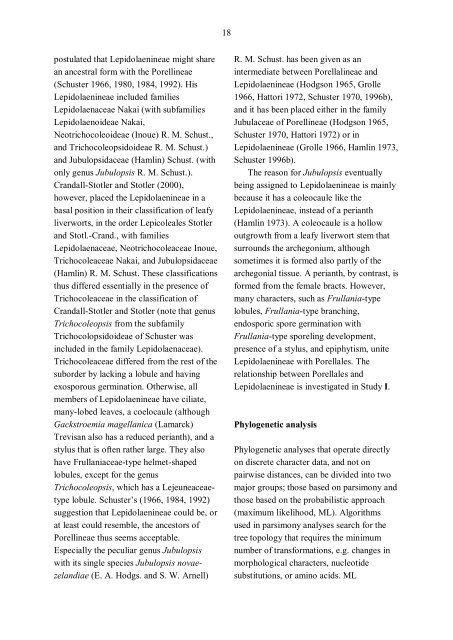Evolutionary relationships of liverworts with a special focus ... - Doria
Evolutionary relationships of liverworts with a special focus ... - Doria
Evolutionary relationships of liverworts with a special focus ... - Doria
Create successful ePaper yourself
Turn your PDF publications into a flip-book with our unique Google optimized e-Paper software.
18<br />
postulated that Lepidolaenineae might share<br />
an ancestral form <strong>with</strong> the Porellineae<br />
(Schuster 1966, 1980, 1984, 1992). His<br />
Lepidolaenineae included families<br />
Lepidolaenaceae Nakai (<strong>with</strong> subfamilies<br />
Lepidolaenoideae Nakai,<br />
Neotrichocoleoideae (Inoue) R. M. Schust.,<br />
and Trichocoleopsidoideae R. M. Schust.)<br />
and Jubulopsidaceae (Hamlin) Schust. (<strong>with</strong><br />
only genus Jubulopsis R. M. Schust.).<br />
Crandall-Stotler and Stotler (2000),<br />
however, placed the Lepidolaenineae in a<br />
basal position in their classification <strong>of</strong> leafy<br />
<strong>liverworts</strong>, in the order Lepicoleales Stotler<br />
and Stotl.-Crand., <strong>with</strong> families<br />
Lepidolaenaceae, Neotrichocoleaceae Inoue,<br />
Trichocoleaceae Nakai, and Jubulopsidaceae<br />
(Hamlin) R. M. Schust. These classifications<br />
thus differed essentially in the presence <strong>of</strong><br />
Trichocoleaceae in the classification <strong>of</strong><br />
Crandall-Stotler and Stotler (note that genus<br />
Trichocoleopsis from the subfamily<br />
Trichocolopsidoideae <strong>of</strong> Schuster was<br />
included in the family Lepidolaenaceae).<br />
Trichocoleaceae differed from the rest <strong>of</strong> the<br />
suborder by lacking a lobule and having<br />
exosporous germination. Otherwise, all<br />
members <strong>of</strong> Lepidolaenineae have ciliate,<br />
many-lobed leaves, a coelocaule (although<br />
Gackstroemia magellanica (Lamarck)<br />
Trevisan also has a reduced perianth), and a<br />
stylus that is <strong>of</strong>ten rather large. They also<br />
have Frullaniaceae-type helmet-shaped<br />
lobules, except for the genus<br />
Trichocoleopsis, which has a Lejeuneaceaetype<br />
lobule. Schuster’s (1966, 1984, 1992)<br />
suggestion that Lepidolaenineae could be, or<br />
at least could resemble, the ancestors <strong>of</strong><br />
Porellineae thus seems acceptable.<br />
E<strong>special</strong>ly the peculiar genus Jubulopsis<br />
<strong>with</strong> its single species Jubulopsis novaezelandiae<br />
(E. A. Hodgs. and S. W. Arnell)<br />
R. M. Schust. has been given as an<br />
intermediate between Porellalineae and<br />
Lepidolaenineae (Hodgson 1965, Grolle<br />
1966, Hattori 1972, Schuster 1970, 1996b),<br />
and it has been placed either in the family<br />
Jubulaceae <strong>of</strong> Porellineae (Hodgson 1965,<br />
Schuster 1970, Hattori 1972) or in<br />
Lepidolaenineae (Grolle 1966, Hamlin 1973,<br />
Schuster 1996b).<br />
The reason for Jubulopsis eventually<br />
being assigned to Lepidolaenineae is mainly<br />
because it has a coleocaule like the<br />
Lepidolaenineae, instead <strong>of</strong> a perianth<br />
(Hamlin 1973). A coleocaule is a hollow<br />
outgrowth from a leafy liverwort stem that<br />
surrounds the archegonium, although<br />
sometimes it is formed also partly <strong>of</strong> the<br />
archegonial tissue. A perianth, by contrast, is<br />
formed from the female bracts. However,<br />
many characters, such as Frullania-type<br />
lobules, Frullania-type branching,<br />
endosporic spore germination <strong>with</strong><br />
Frullania-type sporeling development,<br />
presence <strong>of</strong> a stylus, and epiphytism, unite<br />
Lepidolaenineae <strong>with</strong> Porellales. The<br />
relationship between Porellales and<br />
Lepidolaenineae is investigated in Study I.<br />
Phylogenetic analysis<br />
Phylogenetic analyses that operate directly<br />
on discrete character data, and not on<br />
pairwise distances, can be divided into two<br />
major groups; those based on parsimony and<br />
those based on the probabilistic approach<br />
(maximum likelihood, ML). Algorithms<br />
used in parsimony analyses search for the<br />
tree topology that requires the minimum<br />
number <strong>of</strong> transformations, e.g. changes in<br />
morphological characters, nucleotide<br />
substitutions, or amino acids. ML
















